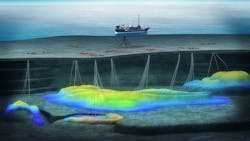NPD draws up shortlist for IOR award
Offshore staff
OSLO, Norway – The Norwegian Petroleum Directorate (NPD) has selected three finalists for this year’s improved oil recovery (IOR) prize.
It will announce the winner at the ONS conference and exhibition in Stavanger on Aug. 28.
The prize is given to a production license, company, project, or individual benefitting activity on the Norwegian continental shelf (NCS) through work related to improved oil recovery.
This year’s contenders, drawn from 26 nominations, are as follows:
1. The licensees for the Alvheim field in the North Sea (Aker BP, Conoco Phillips, and Lundin) for taking risks in order to prove and produce more oil in the area. By implementing newly developed technology, sharing data and being able to view the area as a whole, the NPD said, they have helped to more than double its recoverable reserves.
Marathon originally brought the Alvheim field and its associated FPSO onstream in 2008. Large-scale data acquisition has since led to continuous identification, maturation, and drilling of new well targets, with exploration drilling close to the field leading to discoveries and development of various finds.
In addition, discoveries outside the field area have been tied back to Alvheim, including Vilje, Volund, Bøyla and Skogul, helping to more than double reserves in the Alvheim area from the volume specified in the approved plan for development and operation (PDO) in 2004.
Technologies that have helped optimize output, particularly from the tie-in satellites that largely comprise thin oil columns, are drilling of pilot boreholes and multilateral wells, extensive use of oil and water tracers, four-dimensional seismic surveying, downhole inflow control devices (ICDs), and autonomous ICDs (AICDs).
Positive experience from use of inflow control valves (ICVs) in advanced completion solutions to reduce gas production has increased oil recovery, with plans to install a further automated system (AICV) to shut off unwanted water or gas flow.
A cross-flow water injection well and gas injection with the aid of the gas lift system are other examples of inventive IOR measures cited by the NPD, with polymers injected in one well on the field in order to reduce water production.
2. Resman was established in 2005 on the basis of technology developed by Sintef and the Norwegian Institute for Energy Technology, and is today owned by Nordic Capitol.
The company has developed a method for wireless monitoring of oil reservoirs that provides continuous information from different formations and wells, leading to better reservoir management and improved oil and gas recovery from the field.
Over 30 oil companies worldwide have adopted the technique in more than 400 production wells. It is low cost and accurate compared with traditional production logging, the NPD said.
It employs unique chemical tracer molecules to identify which strata and formations the well is producing from, also providing information on structures and oil saturation in the reservoir.
The tracers are baked into a special plastic matrix and placed in slots built into the completion tubing installed in production wells. These plastic rods contain two types of molecular tracer, released on contact with oil or water.
Sensors are installed in various well zones and the tracers flow up to the platform where samples are taken for lab analysis, allowing the operator to determine when water breakthrough is occurring and to picture the quantities of different fluids flowing from the various zones.
In the Norwegian sector, the technique has been deployed in wells on the Alvheim and Ekofisk fields in the North Sea and on the Åsgard field in the Norwegian Sea.
Resman plans to extend the development to exploration drilling, particularly in wells where rocks from reservoir to surface may be tight. In these cases, the technique could be used in casing to check whether hydraulic communication exists from the sub-surface strata up to the surface.
3. Professor Svein Magne Skjæveland at the University of Stavanger (UiS), who has worked in the petroleum sector since the 1970s.
He has been involved in teaching, research, management and organization, and for many years headed petroleum activities at the Rogaland Regional College – predecessor of the UiS – and Rogaland Research (now Iris).
He developed the first MSc program for petroleum technology in Stavanger, and later helped establishing Stavanger University College’s PhD program in the same subject.
During 1985-91, he also helped plan and implement the Spor (1985-1991) and Ruth (1992-1995) research programs and assisted development of the National IOR Centre of Norway and its Corec predecessor.
06/05/2018
